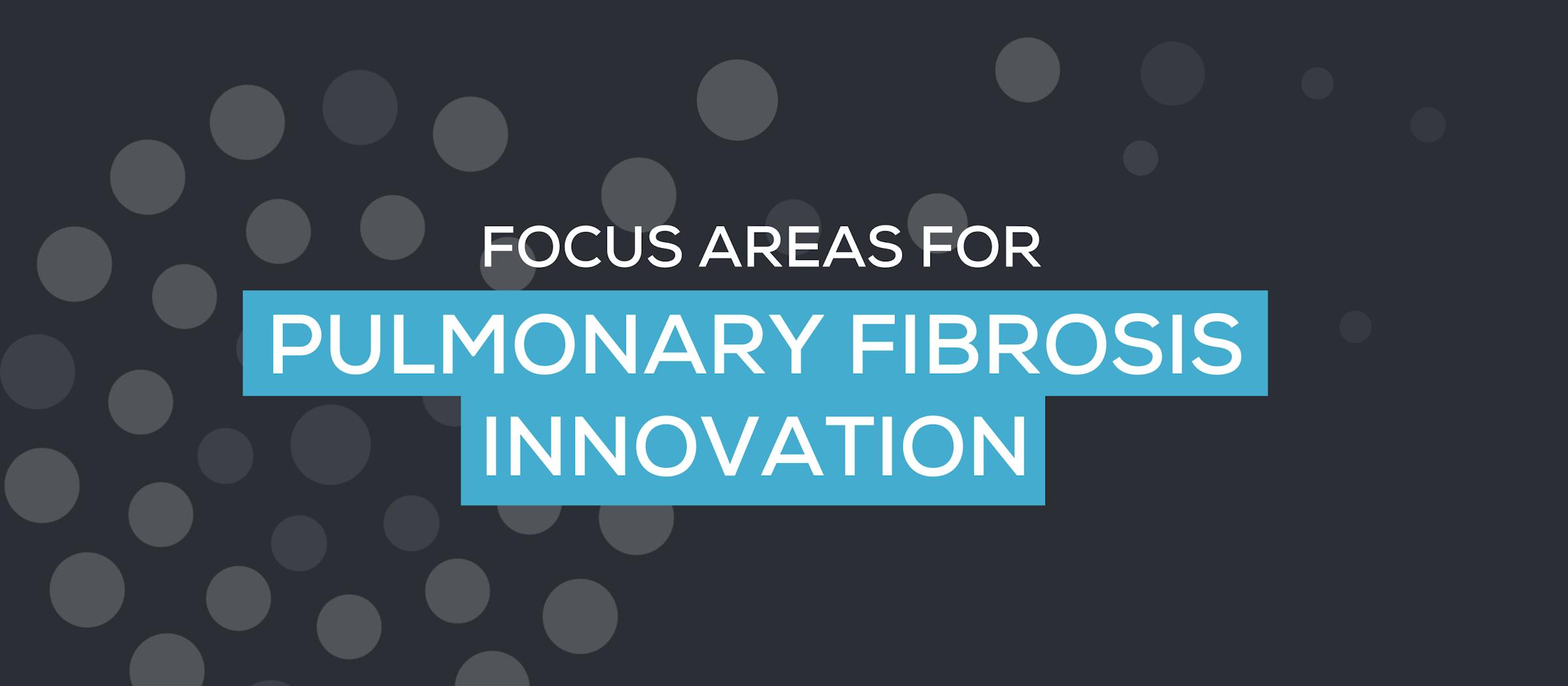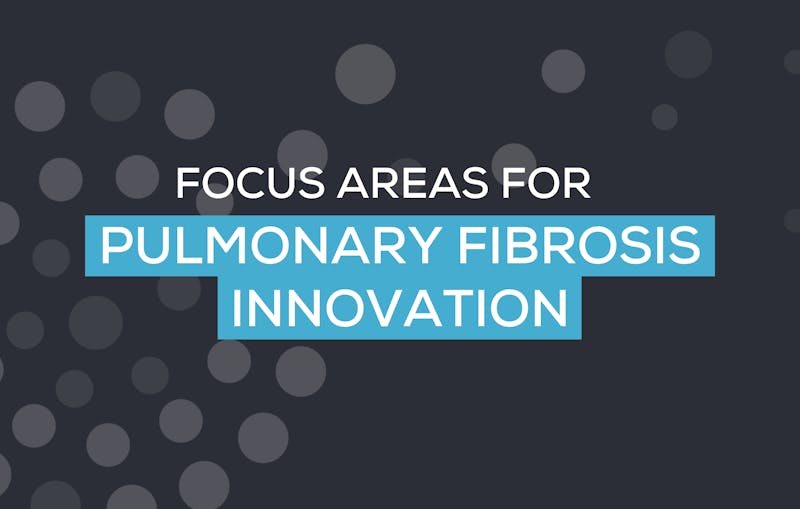Pulmonary health perspectives in the COVID-19 era: Focus areas for PF innovation
On August 18, MATTER, Three Lakes Foundation (TLF) and Pulmonary Fibrosis Foundation (PFF) brought together stakeholders throughout the pulmonary fibrosis (PF) community to discuss challenges in pulmonary health and opportunities to improve PF awareness, diagnosis and care.
PF affects more than three million people globally but remains a disease state with largely unmet need. Part of a family of 200 related lung diseases, PF can easily be disguised by a set of symptoms and ailments that mimic other, more common conditions. About one-third of people are misdiagnosed for well over a year before reaching a PF diagnosis — and once they do, treatment options are limited.
The conversation featured perspectives from patients, caregivers, innovators and healthcare providers. Each shared their own experiences living with, caring for or building solutions for people living with PF — and how healthcare innovators can help by submitting their ideas and solutions to the 2020 PF Innovation Challenge.
You can watch the full event here:
Thank you to the event participants:
- Tom Hurvis, founder of Three Lakes Foundation, PF caregiver
- Dana Ball, executive director of Three Lakes Foundation
- Stephanie Goldman, PF caregiver
- Dr. Maryluz Fuentes, primary care physician and PF patient
- Dr. Fernando Martinez, chief of the division of pulmonary and critical care medicine at New York-Presbyterian Hospital’s Weill Cornell Medical Center
- Eamonn Costello, CEO of patientMpower and 2017 IPF Catalyst Challenge winner
Below are the key areas discussed throughout the event. Responses have been edited slightly for length and clarity.
Why partner on an innovation challenge
Dana: “I believe the time is now to dream big and work as fast as possible to change PF from hopeless to hopeful. Today, Three Lakes Foundation is moving forward with renewed commitment to do everything possible and as fast as possible to improve time to diagnosis and accelerate life saving therapies.
“It’s important to note, we understand that we cannot solve the myriad of pulmonary fibrosis problems alone, and that’s why we work every day to expand our PF community, collaborators and partners. What better way to connect across the globe today and meet new innovators and entrepreneurs during a pandemic, then hosting a virtual challenge?”
Focus 1: Stronger awareness among physicians and the general community
Fernando: “What we have with pulmonary fibrosis is a lack of clear understanding, a lack of how to provide the optimal support for patients and their families…This a disorder that unfortunately presents with symptoms that are very typical of other more common disorders like Asthma. When someone is describing that they’re becoming increasingly breathless, pulmonary fibrosis is an unusual cause of that symptom — but unfortunately, it is one of the most serious causes for those symptoms. We need to develop innovative ways to enhance the awareness of this disease.”
Stephanie: “I can not stress enough the importance of being able to identify early warning signs of this disease. In my mother’s case, for the span of about a year and a half, what we first attributed to a shortness of breath, the need to lose weight and exercise more turned out to be something much more sinister…My mother would put her full faith and confidence in her physician being treated with inhalers and a corticosteroid, and I would research the symptoms, share possible causes and encourage her to inquire with the doctor about the and potential reasons for her illness.”
I can not stress enough the importance of being able to identify early warning signs of this disease. In my mother’s case, for the span of about a year and a half, what we first attributed to a shortness of breath, the need to lose weight and exercise more turned out to be something much more sinister. - Stephanie Goldman
Focus 2: Better diagnostic solutions for early diagnosis
Fernando: “Having been in this field for 30 years, I would like to ensure that whatever therapeutic approach that we take strongly listens to the patient and their caregiver inputs. You really need to consider what the patient needs to be able to function more effectively and to maximize what they want to get out of life. And whatever the therapeutic approach is, it has to incorporate what the patient’s goals are. They’re the ones that are making the call.
“One of the most needed areas for us is simplifying the diagnostic process and providing the patient a clear view of what their expectations should be so that they can make appropriate decisions over the course of their disease course. The way that the cat scans have been interpreted have become much more standardized. Those components have really advanced the field of diagnosis — but even with those advances, there still remains diagnostic uncertainty with people having to undergo surgical biopsies. One of the key areas innovators may want to explore in this particular challenge is the approach to enhancing diagnostic methods.
“One method that’s become standard in oncology is doing liquid biopsies with blood. I’d love to see that in the pulmonary fibrosis field. I’d love to be able to see simple diagnostic modalities that would allow me to look at someone and be able to say you will have a problem in the next year versus you will not have a problem in the next year, so that you can guide how you would like to think about the therapeutic approach.”
Focus 3: Care, treatment and quality of life
Dana: “Innovation of oxygen delivery remains a major unmet need for our community. There are many people working on these technologies to deliver a better product and experience for oxygen users.”
Tom: “My wife’s primary challenge was running out of breath. There was always tremendous anxiety around doing activities and not returning in time to get the oxygen concentrator replenished.”
Fernando: “This is not a subtle disorder. The therapies that need to be developed have to include and have to target improving the patient’s quality of life, improving some of the symptomatic components like the cough.
“The situation now is very different than it was even just a few years ago. There’s clearly been an improvement with regard to our approach to understanding the pathology of the disease, the manifestations, how to diagnose with therapies that work — but we are clearly still not where we need to be. I think a key component of the problem is that none of the treatments that we currently have have much effect on the patient’s impaired quality of life, whether it’s coughing or whether it’s breathlessness. Limitations on the patients and their caregivers are dramatic.”
This is not a subtle disorder. The therapies that need to be developed have to include and have to target improving the patient’s quality of life. - Dr. Fernando Martinez
Maryluz: “After 2014, when the two drugs became available, they said that it would not cure the disease, but it would slow the progression of the condition. So that’s been a tremendous help. But again, it doesn’t address the quality of life. Still, us patients are on oxygen around the clock. And the cough already had a stigma in the past, but that stigma is so much stronger today as a result of COVID-19.”
Eamonn: “It would be great if we could reliably predict and understand the climbs in lung function. It’s quite common that the patients will go back for routine checkup and their lung function will have declined. So if we had a way of understanding or predicting that and being able to treat that, along with quality life, that would massively improve longevity.”
Unique opportunities during COVID-19
Fernando: “On the awareness side, COVID-19 can help us get across to the broader community and the world that lung health is important. Because COVID-19 has a negative effect on the lungs, I think that can aid us indirectly in enhancing awareness of the pulmonary fibrosis community. It’s an opportunity that we have to embrace.
“In the COVID-19 era, it is much more difficult for us to manage our patients, because either the patients are hesitant to come into our healthcare setting, or even simple lung function testing is difficult to obtain now. A lot of us have shifted a lot of our care into a virtual environment. It’s important that innovators think about how we might use technology to aid patients, their families and their clinicians in dealing with the disorder.
Eamonn: “This does present an opportunity — where maybe there were barriers to change how things were done before because where people didn’t want to upset the status quo, COVID-19 has forced change. There’s very limited access to lung function testing. There’s very limited access to all the diagnostics and hospitals. So digital care solutions like ours are now being rapidly deployed by pulmonary fibrosis centers and lung transplant centers to help pulmonary teams connect with patients and understand their lung functions so they can do those diagnostics remotely, and also understand their oxygen status that can do pulmonary rehab remotely.”
Long term benefits of startup participation
Dana: “For anyone thinking of participating in this year’s challenge, It’s important to understand this isn’t a one and done event for TLF. Our goal is to create a global community of the most dedicated, brightest and best talent for this year’s event, but also for future events and new funding opportunities.”
Fernando: “I was not a finalist in the 2017 challenge, and I have still spent years working with Three Lakes Foundation. They’ve been a key member of my clinical work, my investigative studies and my interactions with the financial and business intelligence side.”
Eamonn: “And what innovators will find is that you will not find a better group of patients and physicians and nurses to help you with your development. You’ll make a lot of friends and there will be a lot of fun working in this area, but there is also real commercial potential in this space as well.”
Our goal is to create a global community of the most dedicated, brightest and best talent for this year’s event, but also for future events and new funding opportunities. - Dana Ball, executive director of Three Lakes Foundation
Want to learn more about this challenge?
- Get patientMpower’s advice on how to make your challenge application stand out
- See more patient, caregiver and healthcare provider perspectives
- Submit your application on the challenge site




